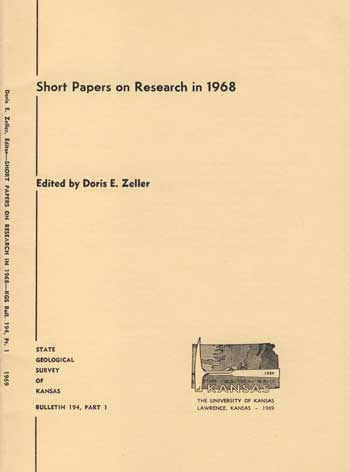
Kansas Geological Survey, Bulletin 194, pt. 1, originally published in 1969

Originally published in 1969 as part of "Short Papers on Research in 1968," Kansas Geological Survey Bulletin 194, part 1, p. 17-18. This is, in general, the original text as published. The information has not been updated.
Absorbent clay granules were prepared from Kansas underclays by the addition of a frothing agent to a clay slip, and then drying, crushing, and calcining the product. Absorbent properties were comparable to those of a commercial product.
An absorbent granule differs from an expanded lightweight granule in that the absorbent granule has a minimum of glass formed within the pore structure. A maximum amount of the pore structure should be open to liquid penetration. Absorbent clay granules suitable for absorbing oil, grease, water, etc., were made from kaolinitic Kansas underclays (Fig. 1). The absorbance of these granules is quite similar to that of absorbent clays from Georgia and Florida.
Figure 1--Crushed absorbent clay granules, x 9.

The laboratory method of making low-density absorbent clay granules was as follows:
A small pilot plant (designed and built by Mr. John H. Denham, Black Diamond Coal Co., Route 1, Weir, Kansas) operation, based on the laboratory procedure, was started in southeastern Kansas, but the work was discontinued after making a study of the competitive material sold in the area. The following are sold as grease absorbent materials:
Comparison of oil absorption properties of the granules from frothed Kansas underclays and a commercial oil absorbent (Table 1) showed that the ability of Kansas granules to absorb oil was slightly better than that of the commercial product. Kansas granules were rough-textured, equiaxed particles. The economics of full-scale manufacturing appear to be marginal, with only the lower cost of shipping into the market area to offset the additional cost of frothing and drying the clay.
Table 1--Comparative oil absorption tests.*
| Commercial oil absorbent |
Absorbent Kansas underclay granules |
|
|---|---|---|
| Weight per cu ft | 31.97 lbs | 27.10 lbs |
| Specific gravity (determined in kerosene) |
2.17 | 1.93 |
| Oil absorption** (weight of absorbent) |
0.417 | 0.435 |
| Time required for saturation |
166 seconds | 84 seconds |
| Kerosene*** absorption test (-16 + 40 mesh) |
20% | |
| * Tests done by Bruce Williams Laboratories, Joplin, Mo. ** Linseed oil (7.75 lbs/gal) used in absorption test. *** Test done in KGS laboratories. |
||
For additional information pertinent to this paper see the following references:
McCarter, W. S. W., 1949, Producing absorbent cleaning composition: U.S. Patent 2,491,051. Dec. 13.
Modde, M. F., and Lawrence, W. G., 1968, Foamed clay-water systems for lightweight aggregate production: Am. Ceram. Soc. Bull., v. 47, no. 3, p. 264-266.
Nicholson, C. M., and Bole, G. A., 1953, Cellulated ceramic for the structural clay products industry: Jour. Am. Ceram. Soc., v. 36, no. 4, p. 127-136.
Kansas Geological Survey, Short Papers on Research in 1968
Placed on web July 26, 2011; originally published in Feb. 1969.
Comments to webadmin@kgs.ku.edu
The URL for this page is http://www.kgs.ku.edu/Publications/Bulletins/194_1E/index.html